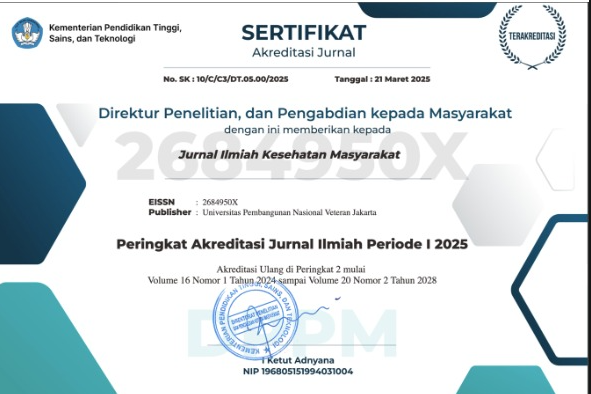Patient Safety Leadership Walkround terhadap Budaya Keselamatan Pasien di Instalasi Farmasi Rumah Sakit Tugu Ibu, Depok
Abstract
Latar belakang: Medication error merupakan penyebab utama cedera dan bahaya yang dapat dihindari dalam sistem health care di seluruh dunia. Budaya keselamatan merupakan faktor makroorganisasional yang dapat berdampak positif pada keselamatan kerja. Patient safety leadership walkround merupakan salah satu strategi dalam meningkatkan budaya keselamatan pasien. Penelitian ini ditujukan untuk mengetahui hubungan patient safety leadership walkround terhadap budaya keselamatan pasien di instalasi farmasi
Metode: Penelitian cross sectional dengan populasi adalah seluruh staff di instalasi farmasi Rumah Sakit Tugu Ibu Depok antara Februari dan Juni 2018. Sampel sebanyak 30 orang apoteker diambil secara total sampling. Instrumen yang digunakan adalah kuesioner PSOPSC atau kuesioner Pharmacy Survey On Patient Safety Culture yang diterbitkan oleh Agency for Healthcare Research and Quality dan Untuk pertanyaan mengenai Patient Safety Leadership Walkround atau ronde keselamatan pasien merupakan adaptasi pertanyaan dari Patient Safety Walkrounds Toolkit. Chi square digunakan untuk analisis data.
Hasil: Hasil analisis bivariat menyatakan bahwa terdapat hubungan yang signifikan antara intensitas paparan walkround (p=0,012) dan komitmen pemimpin saat walkround (p=0,026) dengan budaya keselamatan pasien.
Kesimpulan: Terdapat hubungan antara intensitas paparan walkround dan hubungan komitmen pemimpin saat walkround terhadap budaya keselamatan pasien. Sedangkan keterbukaan komunikasi saat walkround dan kemampuan menindaklanjuti umpan balik tidak terdapat hubungan terhadap budaya keselamatan pasien.
Backgound: Medication errors are a major cause of injury and dangers that can be avoided in the health care system worldwide. Safety culture is macroorganizational factor that can have a positive impact on work safety. Patient safety leadership walkaround is one of the strategies to improve the patient safety culture. This study aimed to determine the raltionship of patient’s walk safety leadership to the culture of patient safety in pharmaceutical installations
Method: A cross sectional study with a population of all staff at Depol Tugu Hospital pharmacy installation performed between February to June 2018. A sample of 30 pharmacists was taken in total sampling. The instrument used was the Agency for Healthcare Research and Quality and for questions about the Patient Safety Leadership Walk or patient sfety rounds were adaptions to questions from the Patient Safety Walkarounds Toolkit. Chi Square is used for data Results: The bivariate analysis revealed that there was a significant relationship between the intensity of walkaround exposure (p=0.012) and leader commitmet at walkaround (p=0.026) with the patient safety culture. Conlusion: Relationship was found between the intensity of walkaround exposure and the relationship of leader commitment ehn walking towards the patient’s safety culture, while openness of communication when walking and the ability to follow up on feedback are not related to the patient safety culture
References
American Pharmacists Association 2016 „Pharmacists‟ Impact on Patient Safety‟. Available at: http://www.pharmacist.com/sites/default/files/PharmacistsImpactonPatientSafety_Web.pdf.
Departemen Kesehatan Indonesia Direktorat Jenderal Bina Kefarmasian dan Alat Kesehatan 2008 „Tanggung Jawab apoteker Terhadap Keselamatan Pasien ( Patient Safety )‟, Tanggung Jawab Apoteker Terhadap Keselamatan Pasien ( Patient Safety), pp. 30–40.
Elden, N. M. K. and Ismail, A. 2015 „The Importance of Medication Errors Reporting in Improving the Quality of Clinical Care Services‟, Global Journal of Health Science, 8(8), p. 243. doi: 10.5539/gjhs.v8n8p243.
Salmasi, S. et al. 2015 „Medication Errors in the Southeast Asian Countries : ASystematic Review‟, pp. 1–19. doi: 10.1371/journal.pone.0136545.
Budihardjo, A. 2008 „Pentingnya Safety Culture Di Rumah Sakit: Upaya Meminimalkan Adverse Events‟, Integritas - Jurnal Manajemen Bisnis, 1(Mei), p. 53.
Institute for Healthcare Improvement 2004 „Patient Safety Leadership WalkRounds‟, pp. 1–11. Available at: papers2://publication/uuid/366CA566-9F0A-4682-B7FC-275D34D57A3B.
Frankel, A. et al. 2003 „Patient Safety Leadership WalkRounds.‟, Joint Commission journal on quality and safety, 29(1), pp. 16–26. Available at: http://www.ncbi.nlm.nih.gov/pubmed/12528570 (Accessed: 28 March 2018).
AHRQ 2017 Leadership Role in Improving Safety. Available at: https://psnet.ahrq.gov/primers/primer/32/leadership-role-in-improving-safety (Accessed: 28 March 2018).
Donaldson, L. J. et al. 2017 „Medication Without Harm: WHO‟s Third Global Patient Safety Challenge‟, The Lancet. World Health Organization; licensee Elsevier, 389(10080), pp. 1680–1681. doi: 10.1016/S0140-6736(17)31047-4.
Morath, J., Filipp, R. and Cull, M. 2014 „Strategies for Enhancing Perioperative Safety: Promoting Joy and Meaning in the Workforce‟, AORN Journal. Wiley-Blackwell, 100(4), pp. 376–389. doi: 10.1016/j.aorn.2014.01.027.
Schell, K. L. and Ph, D. 2014 „Safety Culture : Why It Matters for Pharmacy Safety‟, pp. 1–11.
Singer, S. J. and Tucker, A. L. 2014 „The evolving literature on safety WalkRounds: Emerging themes and practical messages‟, BMJ Quality and Safety, 23(10), pp. 789–800. doi: 10.1136/bmjqs-2014-003416.
Notoatmodjo. Metodologi Penelitian Kesehatan. Jakarta: PT. Rineka Cipta; 2010.
Sir Liam Donaldson 2017 „Medication Without Harm‟, p. 16.
Sexton, J. B. et al. 2014 „Exposure to Leadership WalkRounds in neonatal intensive care units is associated with a better patient safety culture and less caregiver burnout.‟, BMJ quality & safety. BMJ Publishing Group Ltd, 23(10), pp. 814–22. doi: 10.1136/bmjqs-2013-002042
Sølvtofte, A.-S., Larsen, P. and Laustsen, S. 2017 „Effectiveness of Patient Safety Leadership WalkRoundsTM on patient safety culture‟, JBI Database of Systematic Reviews and Implementation Reports, 15(5), pp. 1306–1315. doi: 10.11124/JBISRIR-2016-003004.
Christina Pellegrini, B. J. And M.A 2016 „Leadership, Communication And Healthcare: Understanding The Role Of Communications In Building Collaborative Healthcare Teams‟, (August).
Data and statistics‟ 2018. World Health Organization. Available at: http://www.euro.who.int/en/health-topics/Health-systems/patient-safety/data-and-statistics (Accessed: 17 March 2018).
Kate Fenner, RN, P. (no date) The Joint Commission’s 2017 National Patient Safety Goals. Available at: https://www.compass-clinical.com/the-joint-commission-national-patient-safety-goals-for-2017/ (Accessed: 28 March 2018).
Kemenkes 2016 „Peraturan Menteri Kesehatan Republik Indonesia Nomor 72 Tahun 2016 Tentang Standar Pelayanan Kefarmasian Di Rumah Sakit‟, (49).
Leadership Role in Improving Safety 2017. Available at: https://psnet.ahrq.gov/primers/primer/32/leadership-role-in-improving-safety (Accessed: 28 March 2018).
Nurhikmah Panjaitan 2015 „Jurkessutra (Jurnal Kesehatan Surya Nusantara)‟, 2(5), pp. 40–47.
Feitelberg, S. P. 2006 „Patient safety executive walkarounds.‟, The Permanente journal, 10(2), pp. 29–36.









.jpg)








